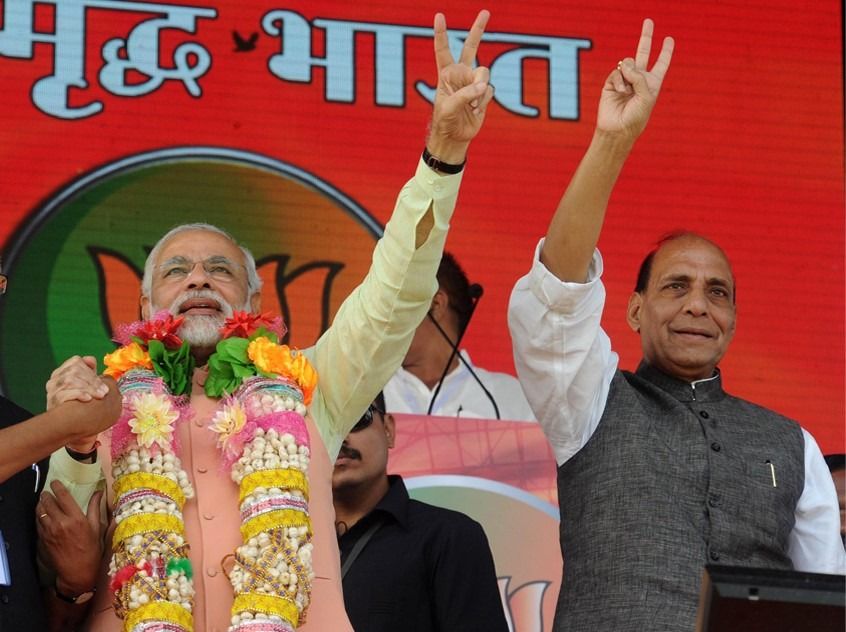Is India “creatively reinterpreting” its no-first-use policy?
By John Krzyzaniak | August 30, 2019
 Indian Prime Minister Narendra Modi and Defense Minister Rajnath Singh, 2013. Credit: Wikimedia Commons.
Indian Prime Minister Narendra Modi and Defense Minister Rajnath Singh, 2013. Credit: Wikimedia Commons.
Donald Trump isn’t the only one who can change long-standing policy by tweet. On August 16, the Indian defense minister Rajnath Singh took to Twitter during a visit to Pokhran, the site of India’s 1998 nuclear tests. He wrote that, up until now, India has strictly adhered to the doctrine of no nuclear first use, but stipulated that “what happens in the future depends on the circumstances.” (To be fair, Singh delivered his statement orally before tweeting it.)
Singh’s statement caused a stir among South Asia pundits and arms control experts, but to the uninitiated, it might have been difficult to understand what all the hoopla was about. After all, what’s a one-off statement by a defense minister? Isn’t India’s official doctrine still unchanged? And shouldn’t we really concern ourselves with deeds, not just words?
A research paper by Christopher Clary and Vipin Narang, published earlier this year in the top-ranked academic journal International Security, explains why the Indian defense minister’s recent statement matters so much.
As the authors explain, India has produced only one official nuclear doctrine, which it summarized publicly in 2003. A key pillar of that doctrine is an unequivocal no-first-use policy, meaning that India would only use nuclear weapons in retaliation. The summary also states that a retaliatory strike would be “massive and designed to inflict unacceptable damage,” implying that it would likely be aimed at an adversary’s civilian population centers.
There are just two problems for India. First, this so-called “massive retaliation” policy is not entirely credible. In a hypothetical scenario where an adversary targets, for example, an Indian military base with a single, relatively small nuclear weapon, it is hard to imagine India responding with an attack that annihilates millions of innocent people.
Second, the massive retaliation policy has been unhelpful in deterring Pakistan from sponsoring terrorist attacks on Indian soil, such as the 2008 Mumbai attack. India’s default option for responding to such attacks and punishing Pakistan would be a limited conventional strike. However, Pakistan has no reservations about nuclear first use and has indicated that it would use tactical or “battlefield” nuclear weapons on Indian ground forces in certain situations. So India has no way to respond to terrorist attacks without running the risk of escalating to a nuclear exchange. Clary and Narang call this “strategic paralysis.”
India’s solution, Clary and Narang argue, has been to develop a “counterforce” capability that would give India the option to target Pakistan’s nuclear forces rather than its population centers. Since 2003, India has been building more precise, more accurate missile systems in larger numbers. It has also been improving its ability to monitor Pakistan’s nuclear forces. As the authors write, few if any of these capabilities would be needed for an ordinary massive retaliation strategy.
These new capabilities have given way to new temptations. If we could destroy Pakistan’s entire nuclear arsenal in one fell swoop, Indian officials might reason, then why should we sit with our hands tied waiting for Pakistan to strike us with nuclear weapons before we do so? Why rule out a pre-emptive strike?
This is where India’s no-first-use policy and Defense Minister Singh’s remarks become important. Singh is the highest serving official to suggest changes to India’s no-first-use policy, but he is not the first. “In recent years, serving and retired Indian officials have begun arguing for greater flexibility in India’s existing nuclear doctrine—or asserting that its existing doctrine is already more flexible than commonly assumed,” Clary and Narang write.
If Clary and Narang have reasoned correctly and we are witnessing a change in India’s nuclear strategy, what are the risks of that change? First, in a crisis, both India and Pakistan would have more incentives to “go first and go massively,” as the authors say. Pakistan would prefer to use its nuclear weapons rather than lose them, and India would want to try and disarm Pakistan before getting hit. Second, even in peacetime there would be dangerous costs. Pakistan will build more weapons, put them in more places, and take greater measures to hide and protect them; India will look for better ways to find and target those weapons.
Publication Name: International Security
To read what we're reading, click here
Together, we make the world safer.
The Bulletin elevates expert voices above the noise. But as an independent nonprofit organization, our operations depend on the support of readers like you. Help us continue to deliver quality journalism that holds leaders accountable. Your support of our work at any level is important. In return, we promise our coverage will be understandable, influential, vigilant, solution-oriented, and fair-minded. Together we can make a difference.
Keywords: India, Pakistan, counterforce, minimum deterrence, no first use
Topics: Nuclear Risk, What We’re Reading














